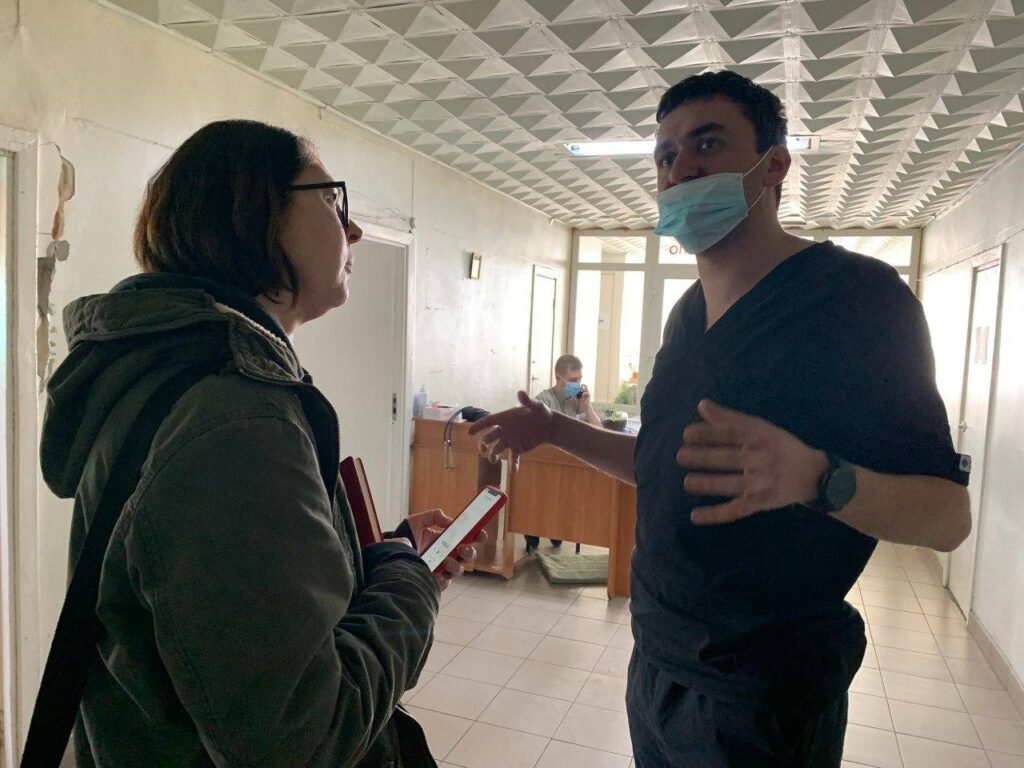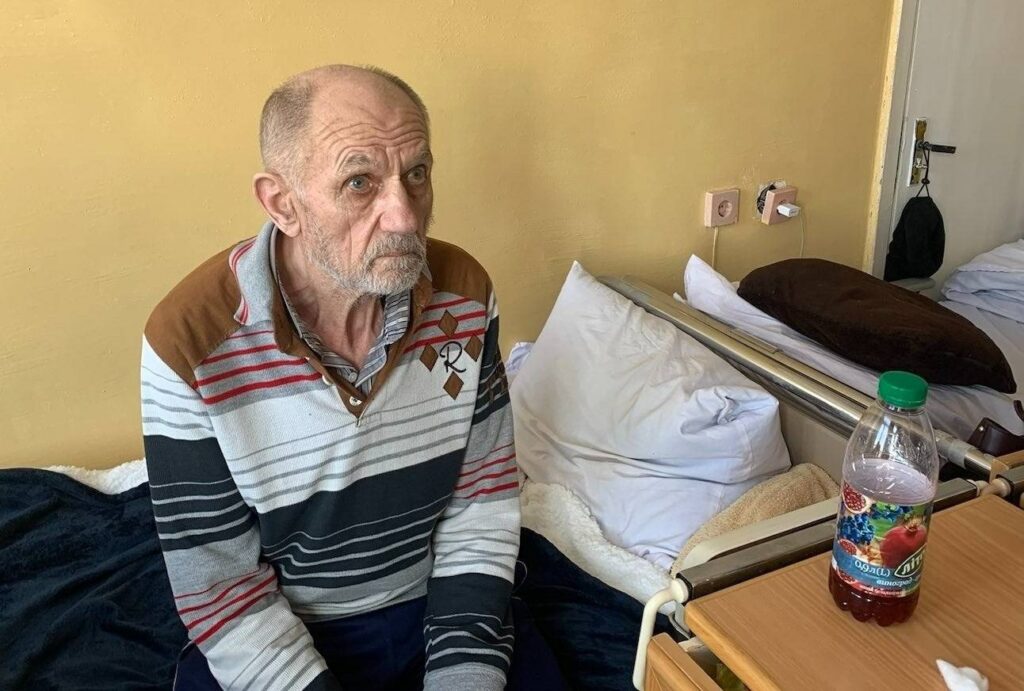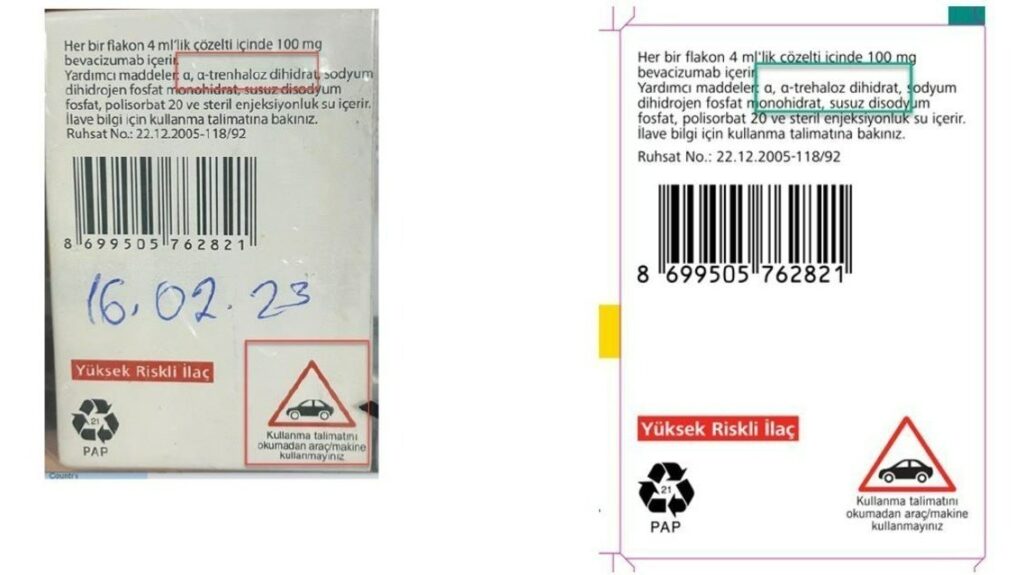The story of mass vision loss among the patients of Chortkiv hospital in Ternopil oblast has every chance of becoming the largest case of medical malpractice in Ukraine. Still, this very incident stood a good chance of remaining unknown to the wide public, as the health workers tried to sweep it under the carpet.
This story was given some publicity after the matter-of-fact, yet formal report from Ternopil police that affected patients’ families applied to. However, the police do not disclose any details. Health workers keep quiet too, and the patients just don`t understand what injection they were given.
Nashi Groshi.Lviv editorial team has been working at this complex investigation for several weeks, but now we know that Ukrainian health workers can substitute the prescribed medicine for prohibited drug of unknown origin just to make several thousand hryvnias.
The Black Day
On the morning of Thursday, February 16, Ivan Yakymets, 54, came to Chortkiv central city hospital for a planned procedure. He was to get an injection into his left eye which had started deteriorating. That was the third procedure of this kind for Ivan who works as a driver.
“After the first two injections I noticed I was improving. Blood started clearing up, I could see everything, except it was a bit cloudy… But February 16 became a black day”, says Ivan Yakyments, who went completely blind in left eye several hours after the injection.
We trusted our doctors; they said I have to get an injection, so I did. I received an injection in the morning, but in 5 hours everything just burned”, another patients of Chortkiv health workers shares his feelings talking to Nashi Groshi.Lviv. He asked to remain confidential. As a result, he lost vision in both eyes.
Overall, 22 patients received eyeball injections that morning; some of them in one eye, and some in both eyes. After several hours all of them suffered from rapid loss of eyesight and felt sharp pain and burning in their eyes. Chortkiv health workers understood that the situation spanned out of control, and the next morning all the affected patients were urgently sent to Ternopil regional clinical hospital. In the hospital they were diagnosed with peracute endophtalmitis and subjected to urgent operations.
“We removed the eye tissue affected by inflammation. It’s an intraocular surgical procedure, an extremely complex surgery. Surgeons were operating all night long; 27 surgeries were performed on 22 patients”, said Vasyl Bliakhar, chief doctor of Ternopil hospital to “Suspilne” channel after several days. Presently he declines any comment.
Acute endophtalmitis is a purulent inflammation of retina’s internal layers accompanied by formation of an abscess in the vitreous body. It is one of the most dangerous ophthalmologic diseases. The main cause of the illness is eye damage which results in bringing of infection.
Preliminary tests done in Ternopil show that the bacteria introduced into the patients’ eyes was colibacillus, states Khrystyna Yakymets, Ivan Yakymets’ daughter. Police which relatives of patients went to after the victims started losing their vision, launched an investigation to establish how it could happen.
Health workers’ reaction and patients’ condition
Making use of the secrecy of investigation, Chortkiv health workers unanimously refused to provide the name of the drug they injected to their patients.
“Unfortunately, I’m unable to give you any comments because of [my] emotional distress”, said in conversation with NashiGroshi.Lviv ophthalmologist of Chortkiv central city hospital Yaroslav Ushii. He was one of three doctors making injections which resulted in patients’ blindness.
Despite his emotional distress, Ushii hopes his patients will recover their sight, even though it’s been quite a long time: “There are no irreversible changes. We’re doing everything and we are treating them. If someone’s head were torn off, then we could say these were irreversible changes, but all of them still have their eyes and it’s too early to talk about [permanent blindness]”.
However, it’s been a month and no patients regained their vision. Only some of them can react to light. Most likely, all of them will remain blind.
How doctors lie
All the patients of Chortkiv hospital had certain problems with their vision before. Most of them were diagnosed diabetic retinopathy. It is a disease of retina, when diabetes negatively affects blood supply of small vessels which in the long run can cause vision loss. To stop this process, so-called anti-VEGF-therapy is conducted.
Neither victim was able to give journalists the name of the medicine they had been injected. They told the same to the police – doctors just didn’t give them the name of the drug.
According to the information NashiGroshi.Lviv received from Ternopil police, investigators recovered the drug Altuzan with active substance bevacizumab for expert examination. Doctors in Ternopil who had to perform urgent surgeries on the patient confirmed that the drug with the same active ingredient had been used in Chortkiv.
Local health workers were trying to hide the name of this drug both from the patient and the journalists. Moreover, they were consciously deceiving patients. This is confirmed by discharge papers given to Mariia Senyshyn, 62. Ternopil health workers wrote that in Chortkiv she was injected aflibercept in both eyes, as was stated by her. It is the active ingredient of the German medicine Eyelia centified in Ukraine. In reality, Mariia was injected Altuzan (bevazicumab) and she lost vision in both eyes.
What is Altuzan?
Altuzan is a drug produced by the Swiss company Roche only for the Turkish market, and it’s not certified in Ukraine. Even in Turkey this medicine is allowed only to treat certain cancers, but not in ophthalmology.
Some time ago Turkish health workers were also using Altuzan in ophthalmology under off-label procedure, when medicine meant for certain disease are showing good results in treating another disease. Still, following the incident in Kirikkale, central Turkey, when 36 patients altogether lost their vision (some of them managed to regain it later), in 2020 the local Ministry of Health prohibited any use of Altuzan in ophthalmology.
Falsifying a prohibited drug
For some casualties in Chortkiv incident it wasn’t the first time when they received eyeball injections. All of them state that no injections caused any issues before. Halyna Zraichyk, wife of one of the patients, told us that her husband had received two previous injections with a drug called Avastin. Last time they changed the drug but never told them the name.
“After two injections and three laser therapy procedures his condition improved considerably. The last injection was supposed to fix the result, and glasses were being adjusted for him. He’s a driver,” says the wife of Orest Zraichyk, 47, who lost vision in both eyes. Like we established before, instead of the Avastin he was promised, Orest was injected Altuzan.
Active substance in Avastin is the same as in Altuzan – bevazicumab. The difference is that Avastin is indeed used in ophthalmology sometimes, both in Ukraine and other countries, and not without unpleasant consequences (we’ll talk about these later).
Both drugs, in fact similar, are manufactured by a Swiss company Roche which is marketing them as medicine against certain types of cancer. However, Avastin has been certified in the EU, US and Ukraine, unlike its Turkish alternativeAltuzan – and is allowed to be used in ophthalmology under off-label procedure.
This means that Altuzan could only have gotten to Chortkiv as a contraband, because it’s can’t be supplied through legal channels. Still, Altuzan can be easily bought in Ukrainian online pharmacies.
It’s much worse that the drug used by Chortkiv health workers turned out to be a counterfeit, that is, an imitation of unknown origin. It comes up from the statement of the State Service of Ukraine on Medicines and Drugs Control (StateMedService) which, with reference to the Roche company, identified the signs of counterfeiting the drug confiscated in Chortkiv on February 16 and mistakes in marking.
Why were health workers using Altuzan?
Sad as it is, the answer to this question is the health workers’ greed. The thing is that one 400 mg/16 ml bottle of Avastin is intended for 28 injections and costs 36,000-38,000 hryvnias. This means that one injection costs around 1,300 hryvnias. On the contrary, a similar bottle of original Altuzan costs 14,000-16,000 hryvnias, so the net cost of one injection is less than 600 hryvnias. At the same time, every patient of Chortkiv hospital paid 2,000 hryvnias despite the fact they were injected a counterfeit and not the original medicine.
Why Ukrainian ophthalmologists are using not all the way legal drugs (but not Altuzan)
Only two drugs are certified in Ukraine for diabetic retinopathy treatment: Eyelia (active substance aflibercept) and Lucentis (ranibizumab). These drugs are much more expensive (for instance, Eylea’s price is 6,500-9,000 hryvnias per injection), and patients need such injection at certain interval, 5-7 times a year.
That’s why Ukrainian ophthalmologists, similar to their colleagues abroad, often use the cheaper Avastin from the Swiss company Roche. It doesn’t hold manufacturer’s certification to be used in ophthalmology, but it’s allowed under off-label procedure in many developed countries – though not in Ukraine.
Ihor Novytskyi, a well-known ophthalmologist from Lviv, was using Avastin because of its affordable price, similar to many other Ukrainian doctors.
“When patients come to us, we tell them there are two options. We can inject either Eyelia or Avastin, and people mostly choose the second option, because they can’t afford to pay for expensive treatment”, says Novytskyi. “Now, after the incident in Chortkiv, we stopped using Avastin, but it will hit patients in the pocket, for most of them can’t afford Eyelia”.
Ihor Novytskyi also said that he repeatedly requested the Ministry of Health to develop a Ukrainian off-label protocol to use Avastin in ophthalmology, but to no avail. The Ministry of Health ignored NashiGroshi.Lviv’s question about the reasons behind their refusal.
Avastin is widely used both in Europe and in the USA, first of all because of its lower price compared to Lucentis or Eyelia which are officially intended to treat retina dystrophy. According to Taras Litvin, head of optometry department with UCSF Medical Center in San-Francisco, one injection costs around $60.
Avastin is indeed widely used in the US, and the side effects statistics is really low”, the American ophthalmologist informed NashiGroshi.Lviv. “But you need to understand that for any eyeball injections there is a risk of infection. Patients are warned about these risks and that the drug is used off-label. There are several ways to prevent infection. Either antibiotic or antiseptic drug is put into the patient’s eyes before the procedure. So, the risks are really small, but they do exist.”
What causes vision loss?
The incidents when patients get infected during injections do happen. For instance, in Veterans Affairs medical center in Los Angeles in 2011 or in Moscow private clinic in 2016. In both cases investigation confirmed that patients lost their eyesight because of improper use of Avastin and not because of the characteristics of the drug itself.
The matter is that Avastin has to be used immediately after opening; that’s why ophthalmologists who, unlike oncologists, are using much smaller dosage, are dividing one bottle between many patients, which significantly increases the risk of introducing the infection.
Here we should recollect the 22 patients of Chortkiv hospital who were brought together specifically for the purpose of using the entire bottle at once. So, colibacillus which caused lightning-fast progress of acute endophtalmitis and, as a result, vision loss, could have been introduced while the drug was dilutes with NS, says a well-known Ukrainian ophthalmologist who asked to remain confidential. “It was either the solution used to dilute the drug had been infected, or the technology during the procedures wasn’t maintained properly. Most often such incidents happen during dilution of the drug. Due to loss of sterility infection can get into an eye and cause endophtalmitis,” he says.
Oksana Vitovska, chief non-staff ophthalmologist with the Ministry of Health, refused to comment on the situation in Chortkiv for NashiGroshi.Lviv.
Similar case in Lviv
While preparing to publish this investigation, NashiGroshi.Lviv learned from several independent sources about a similar incident that happened several weeks age in Lviv Regional Clinical Hospital where eight patients lost vision after Avastin injection. However, unlike in Chortkiv, no one went to the police; so, Lviv health workers are trying to help the patients recover their sight and keep it quiet.
Oleksandra Pavliv, head of ophthalmology department in Lviv Regional Clinical Hospital, neither confirmed nor refuted the information about the unfortunate incident in the hospital, and head doctor of Lviv Regional Clinical Hospital refused to provide any information whatsoever, oral or written. Orest Chemerys, head of Healthcare Department with Lviv Regional Military Administration, stated that neither hospital administration nor patients informed him about the cases of patients losing vision.
So, if you or your relatives lost sight as a result of a similar incident or you work in Lviv Regional Clinical Hospital and can provide more information, contact NashiGroshi.Lviv editorial team at our email editor@ngl.media (confidentiality guaranteed).
What’s next?
Ternopil police started an investigation under art. 140 of the Criminal Code of Ukraine (health workers or pharmacists’ improper performance of their professional duties). The recovered bottle of Altuzan was sent to Kyiv for expert examination, and the results haven’t been back yet.
The affected patients received free post-surgery treatment for almost a month. Doctors are offering lens replacement surgery to some of them. It’s not clear whether this surgery would help, because lens replacement surgery is recommended for cataract (eye lens opacity), and not for retina issues, as several ophthalmologists explained to NashiGroshi.Lviv.
Is it worthwhile going to court?
Do the victims stand any chance to obtain at least justice, if not regain their vision? Nataliia Radionova, a lawyer specializing in medical cases believes they do.
“Any patient has the constitutional right to safe medical care, and medical institutions or doctors who violated this right have to compensate for both moral and material damage.
Speaking of material damage, it is calculated based on treatment expenses, which includes transportation. Additional surgeries and rehabilitation service are also taken into account. Loss of productivity, that is, missed profit is also regarded as material damage.
In this case, when vision is lost, it is a life-changing experience and irreversible damage to a person’s health. If a person was capable to work and lost vision, we can calculate material loss based on average income they had before they lost their vision until retirement age. However, courts can consider cases and take decisions at their own discretion.
The most complicated part is compensating moral damages. Our legal system has been in place for a long time now, but there are still no clear criteria to identify the depth of suffering related to moral and psychological damage. So, it’s hard to substantiate large payments. Everything depends on lawyer’s skills, how well he’s able to collect evidence, conduct competent psychological expert evaluation and substantiate the moral injury and how much it affected the lifestyle and the person’s capabilities in general. We do understand that doctors and the healthcare facility will reject those amounts and do their best to decrease them. And they will surely hire lawyers too.
Our court practice is quite ambiguous in these cases. There are quite absurd precedents. For instance, Podilskyi district court in Kyiv considered a case where a 9-year-old boy’s eye surgery went wrong resulting in vision loss in one eye. Moral damages were awarded only in amount of 9,000 hryvnias. On the contrary, the same court awarded 600,000 hryvnias in moral damages to a woman whose dental treatment of two teeth weren’t up to the standard. That is, because of the absence of clear-cut criteria our courts are, excuse me, playing games and everything depends on lawyers’ skills.
Law enforcement should definitely consider both the article about medical negligence and documents forgery, because when health workers stared covering their tracks, they also forged medical documentation which is an separate additional article.
When we talk about the [used] drug, we come across an interesting moment: how did they get it, if it’s not registered in our market? A hospital is liable for standards of services provision, and if it uses drugs of unknown origin – that is, those that hadn’t been officially procured or brought by the patient himself – numerous questions about its use and the hospital’s commercial activity arise. In fact, it’s the illegal activity.
Patients can request the hospital through the pre-trial procedure for compensation of moral and material damages, including expenses for further rehabilitation or surgery. If the hospital is interested to keep their reputation, they can start settling this issue right now. It won’t save them from criminal liability, but people may start receiving something.
Also, while pre-trial investigation is happening, it’s possible to prepare civil suits which can be filed against the persons to be officially charged. Civil suit is filed either during pre-trial investigation or during the first appointed court session. In addition to moral and material damages, it’s possible to demand compensation of legal fees. So, I advise people to go to the nearest pro bono legal aid bureau where they will be given a lawyer at the expense of the state. Or, if they go to a private lawyer, they can enter legal fees into compensation list.




